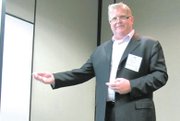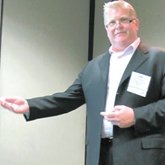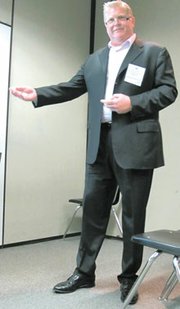Technology in the Trenches
Companies look to technology to navigate the difficult economic terrain.
Amid a challenging economic climate—and facing many regulatory requirements—apparel makers are urged to look to the future and embrace technology to help navigate the difficult economic terrain.
“There is always something that affects the apparel industry,” said Ilse Metchek, president of the California Fashion Association. Issues such as the slowly recovering economy, regulatory issues, two-way trade imbalances and pending regulations continue to challenge the apparel industry, she said.
Software, such as enterprise resource planning (ERP) or product lifecycle management (PLM), can help manufacturers streamline their supply chain, eliminate waste in the production process, and adhere to the timetable to efficiently meet deadlines and shorten production turn time.
In addition, developments such as radio frequency identification (RFID) technology can help streamline retail operations through efficient inventory management and timely reorders. Challenging landscape
Technology represents the future of the industry, said Metchek, speaking to a group of industry executives and technology providers, “and that’s why you are all here.”
Metchek was serving, for the second year in a row, as the keynote speaker for Apparel magazine’s 2010 Tech Conference West, held March 23 at the Fashion Institute of Design & Merchandising in Los Angeles. The event included speakers from various technology providers as well as table-top presentations.
While spending on luxury goods remains down, retailers have been reporting an uptick in spending among middle-income consumers so far this year, Metchek said, but she warned about a stall in sales during March and April when shoppers see their credit card balances from the holidays. The uptick, which Metchek attributes to pent-up demand and “frugal fatigue,” will be evident again in May, she predicted.
Regulatory issues continue to rankle apparel makers and create new technology needs. The Consumer Product Safety Improvement Act, which monitors the amount of lead in consumer products, places the burden of proof on manufacturers or importers to make sure imported or domestic goods do not contain lead. Products must go through a certification process. The “10+2” regulation, which went into effect in April 2009, requires importers and shippers to provide 12 points of information 24 hours before shipments leave port. That information includes the names and addresses of the manufacturer, the buyer and the seller; county of origin; container-stuffing location; commodity numbers; and consignee number. Both of these issues, which were major focuses during the 2009 Tech Conference, are being addressed by a variety of PLM technology providers, but they remain key concerns for apparel makers and importers.
On the horizon are more regulatory issues that could affect California’s apparel makers—including two pieces of legislation that could have an impact on apparel manufacturers shipping to stores in Illinois or Washington state. Illinois’ Lead Poisoning Prevention Act applies to all children’s products and requires a warning label on those products containing more than 40 parts per million of lead. Adult products containing more than 600 parts per million of lead come under the regulation, as well. The LPPA, Metchek said, requires the same testing certification as the Consumer Product Safety Improvement Act with additional labeling. Washington’s Children’s Safe Product Act, which is currently a “pilot ruling,” requires the disclosure of “chemicals of concern” on all children’s products and requests that manufacturers file a report of all the children’s products they sell to Washington-state retailers.
Metchek said apparel manufacturers will find it difficult to comply with these regulations because the 32 laboratories in the country certified to perform the required tests are back-logged.Technology in action
Technology providers partnered with local apparel companies to showcase their offerings and provide real-life examples of their technologies in action. Mark Burstein of New Generation Computing, which produces PLM and sourcing solutions, discussed how the surfwear giant Billabong implemented NGC’s products on a global scale. Billabong, which had revenues of $1.67 billion in 2009, used NGC’s PLM program to shorten lead times, integrate line planning, monitor production activities and plan material requirements.
Brea Haley, an associate designer at Guess, spoke to attendees about Enovia, Dassault Systemes’ PLM program. Guess, which grew to a $2.1 billion company in 2009 from $637 million in 2003, implemented Enovia five years ago. “We needed flexibility, ready access to information, a single version of the truth and more collaboration between departments,” Haley said. The program also helped unify Guess’ three international offices, which are located in Los Angeles, Italy and China.
Owning the most advanced software does not always mean a company’s information-technology workers use it. During the “MRP as Your Primary Engine: How High 5 Sportswear Drove Home Success” seminar, Stillman Saunders, information-technology director of High 5 Sportswear, said his Seattle-based company had advanced material requirements planning (MRP) software last year but the company rarely used it. Instead, High 5 used Excel spreadsheets for much of its planning instead of an MRP program. The company recently installed a new MRP system from St. Paul, Minn.–based Lawson Software. Saunders said Lawson’s M3 system is more efficient than the Excel spreadsheets and offers a more thorough way to plan inventories and match demand for a product with its supply.
Since switching all of its planning functions to Lawson’s software, Saunders said, High 5 does a much better job of forecasting its needs to stock certain inventory for its sportswear, which results in less-stressed employees and more sales opportunities.
However, MRP is not a proverbial silver bullet for a company’s planning issues. “MRP is not a decision-making tool,” he said. Rather, it only provides information.
Technology for radio frequency identification, or RFID, has improved enormously recently, according to Jim Caudill, a senior vice president of marketing and strategy for Texas-based technology company Xterprise.
During his “Lean Retail: Cutting The Fat With RFID” seminar, Caudill said RFID was formerly considered as a technology targeted for manufacturers. Improvements in RFID’s capabilities have opened up new uses for retailers. Radio-frequency tracking takes human error out of crucial retail goals, such as reducing inventory loss or shrinkage, increasing store operational efficiency, and improving responsiveness to consumer demands. Xterprise will debut a new program called Clarity ARS Mobile in the second half of 2010.
Companies Honored for Their Sustainability Efforts
Apparel magazine presented five Sustainability All-Star awards during the 2010 Tech Conference to companies that have taken significant steps toward incorporating sustainable best practices in their businesses.
The five honorees were Nike, Cintas, Intradeco/Dana Undies, GoLite and Hanna Andersson Corp.
Nike was honored for its sustainable practices, including its “Considered Design” program, which strives to reduce or eliminate toxic materials and waste and increase the use of environmentally friendly products in its footwear and apparel. Cintas nominated itself for the award after launching the “Regeneration Suiting Collection,” coordinated tailored pieces made of 100 percent recycled polyester made from post-consumer waste. GoLite, which makes high-performance sustainable apparel for outdoor athletes, was nominated by Outside PR because it has replaced its use of virgin petrochemical-based materials in 100 percent of its main pack fabrics, sleeping bags and luggage with recycled nylons and polyesters. Hanna Andersson Corp., a maker of children’s clothing, was honored for its eco-friendly headquarters and business practices, which include recyclable shipping materials made of post-consumer waste and use of Oeko-Tex Standard 100–certified organic cotton in its entire line. Intradeco/Dana Undies, an El Salvador–based vertical supplier of knit apparel, is the only vertical resource in Central America that spins certified raw bales of organic cotton.—Erin Barajas
























